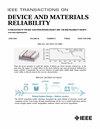利用电探测磁共振和近零场磁电阻检测质子辐照损伤的4H-SiC肖特基二极管
IF 2.3
3区 工程技术
Q2 ENGINEERING, ELECTRICAL & ELECTRONIC
IEEE Transactions on Device and Materials Reliability
Pub Date : 2025-08-12
DOI:10.1109/TDMR.2025.3597973
引用次数: 0
摘要
我们利用电检测磁共振(EDMR)和近零场磁电阻(NZFMR)来识别质子轰击4H-SiC肖特基二极管产生的原子尺度缺陷的物理和化学性质。我们使用EDMR和NZFMR来探索质子辐照产生的深层缺陷,这些缺陷有助于陷阱辅助隧穿肖特基势垒。我们测量了辐照和未辐照二极管的深能级缺陷的自旋相关响应,以比较质子辐照对器件性能的影响。我们观察到未辐照的二极管没有响应,而辐照后的二极管有很大的响应。由NZFMR引起的电流($\Delta {I}$ /I)的最大变化为0.44%,发生在1.3V正向偏置。这种响应的性质与一些关于自旋依赖陷阱辅助隧道(SDTAT)的报道一致[11,15,23,24]。EDMR响应的各向同性g值为2.003,宽度为~10G。我们暂时将这种响应归因于带负电的硅空位(${\ mathm {V}}_{\text {Si-}}}$)。我们的工作表明,EDMR和NZFMR具有研究这些器件中粒子辐照引起的点缺陷的物理和化学性质的灵敏度和分析能力。更重要的是,这表明这些技术可能广泛适用于半导体器件上粒子辐照的研究。本文章由计算机程序翻译,如有差异,请以英文原文为准。
Detection of Proton Irradiation Damage in 4H-SiC Schottky Diodes Via Electrically Detected Magnetic Resonance and Near-Zero-Field Magnetoresistance
We utilize Electrically Detected Magnetic Resonance (EDMR) and Near-Zero-Field Magnetoresistance (NZFMR) to identify the physical and chemical nature of atomic scale defects generated by proton bombardment of 4H-SiC Schottky diodes. We use EDMR and NZFMR to explore proton irradiation created deep level defects which contribute to trap-assisted tunneling through the Schottky barrier. We measure the spin-dependent response of the deep level defect for both an irradiated and unirradiated diode to compare the effects that proton irradiation has on device performance. We observe that the unirradiated diode has no response, and the irradiated diode has a large response. The maximum change in current ( $\Delta {I}$ /I) due to NZFMR is 0.44% which occurs at 1.3V forward bias. The nature of the response is consistent with several reports of spin-dependent trap-assisted tunneling (SDTAT) [11, 15, 23, 24]. The EDMR response has an isotropic g-value of 2.003 and is ~10G wide. We tentatively ascribe this response to a negatively charged silicon vacancy ( ${\mathrm {V}}_{\text {Si-}}$ ). Our work shows that EDMR and NZFMR have the sensitivity and analytical power to study the physical and chemical nature of point defects caused by particle irradiation in these devices. More Importantly, it suggests that these techniques may be widely applicable to investigations of particle irradiation on semiconductor devices.
求助全文
通过发布文献求助,成功后即可免费获取论文全文。
去求助
来源期刊

IEEE Transactions on Device and Materials Reliability
工程技术-工程:电子与电气
CiteScore
4.80
自引率
5.00%
发文量
71
审稿时长
6-12 weeks
期刊介绍:
The scope of the publication includes, but is not limited to Reliability of: Devices, Materials, Processes, Interfaces, Integrated Microsystems (including MEMS & Sensors), Transistors, Technology (CMOS, BiCMOS, etc.), Integrated Circuits (IC, SSI, MSI, LSI, ULSI, ELSI, etc.), Thin Film Transistor Applications. The measurement and understanding of the reliability of such entities at each phase, from the concept stage through research and development and into manufacturing scale-up, provides the overall database on the reliability of the devices, materials, processes, package and other necessities for the successful introduction of a product to market. This reliability database is the foundation for a quality product, which meets customer expectation. A product so developed has high reliability. High quality will be achieved because product weaknesses will have been found (root cause analysis) and designed out of the final product. This process of ever increasing reliability and quality will result in a superior product. In the end, reliability and quality are not one thing; but in a sense everything, which can be or has to be done to guarantee that the product successfully performs in the field under customer conditions. Our goal is to capture these advances. An additional objective is to focus cross fertilized communication in the state of the art of reliability of electronic materials and devices and provide fundamental understanding of basic phenomena that affect reliability. In addition, the publication is a forum for interdisciplinary studies on reliability. An overall goal is to provide leading edge/state of the art information, which is critically relevant to the creation of reliable products.
 求助内容:
求助内容: 应助结果提醒方式:
应助结果提醒方式:


